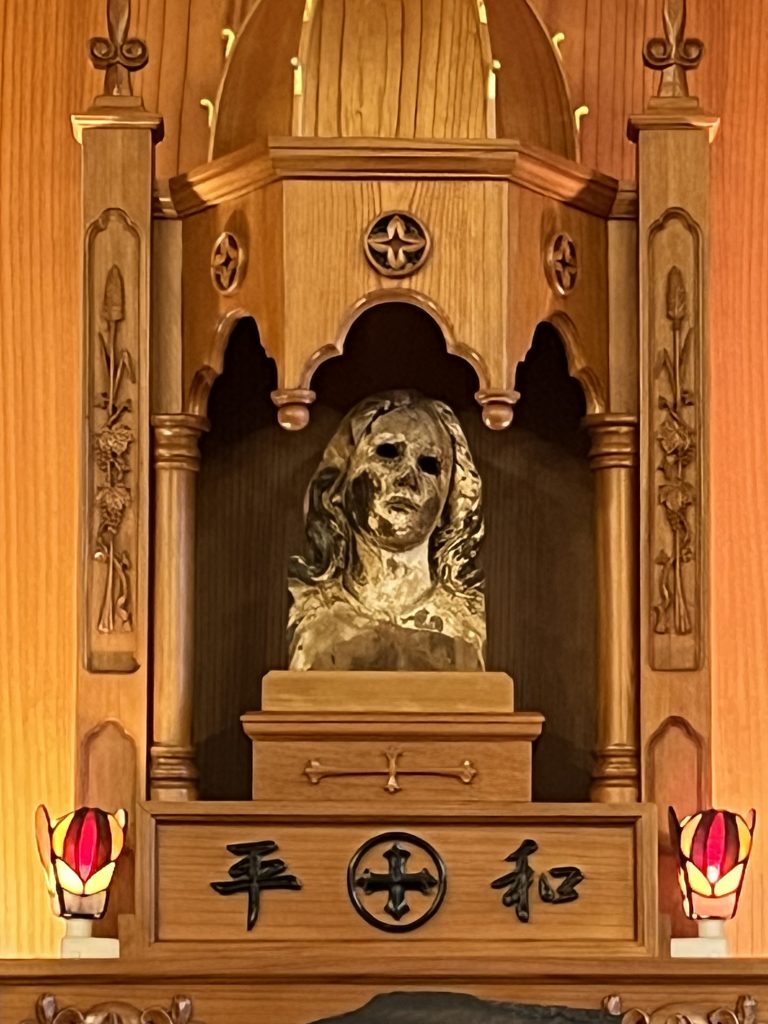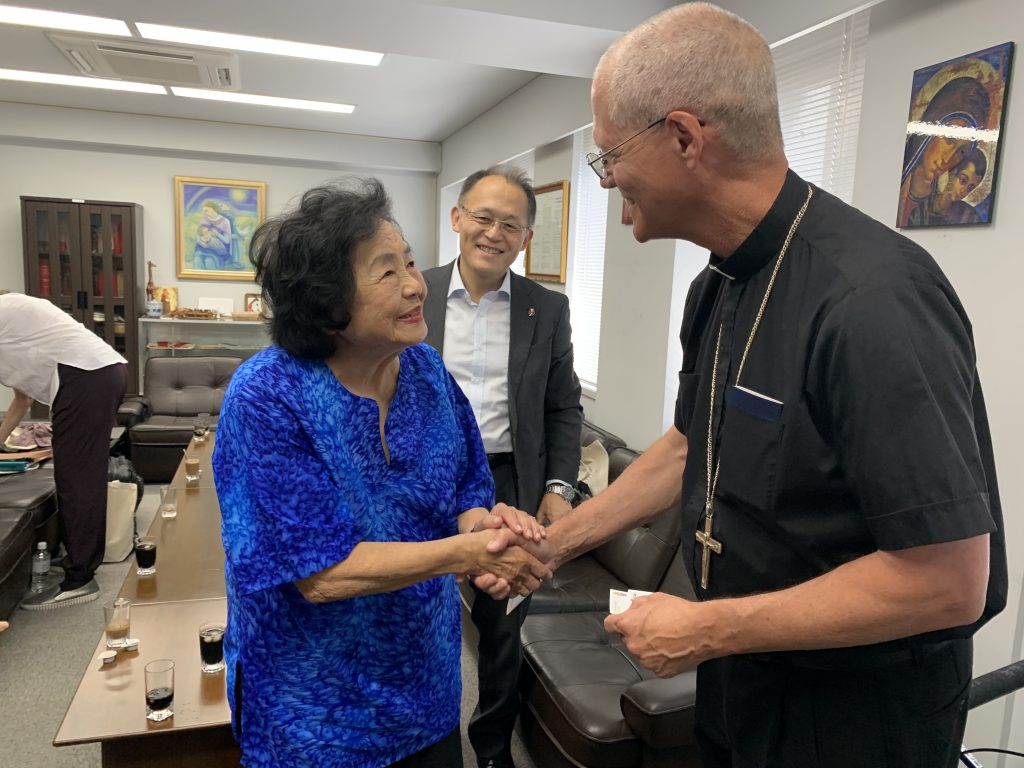As our Pilgrimage of Peace draws to a conclusion, we arrived in Kyoto last night. Today (Friday) is mostly a day of rest, and for some, a bit of sightseeing. Here we will part ways; the Santa Fe contingent will remain until tomorrow, and our Seattle group will depart for Tokyo by train this afternoon to position for a morning flight back to the States Saturday.
 For now, I wish to share a few final thoughts about our Pilgrimage. I learned from Archbishop Takami yesterday that the people of Nagasaki call the above image of Our Lady Hibaku Maria. Hibakusha is the Japanese term for survivors, and this surviving image of Mary has significant meaning to the Catholics of Nagasaki. Even Archbishop Takami is considered hibakusha as he was in the womb of his mother the day of the bombing. He lost siblings and at least one aunt August 9, 1945.
For now, I wish to share a few final thoughts about our Pilgrimage. I learned from Archbishop Takami yesterday that the people of Nagasaki call the above image of Our Lady Hibaku Maria. Hibakusha is the Japanese term for survivors, and this surviving image of Mary has significant meaning to the Catholics of Nagasaki. Even Archbishop Takami is considered hibakusha as he was in the womb of his mother the day of the bombing. He lost siblings and at least one aunt August 9, 1945.
We hear constantly from Pope Francis the importance of going out, of listening in order to better understand, and to bring all of this listening and learning to the Holy Spirit for discernment, to inform how we act to fulfill the mission of the Church today. As Pilgrims of Peace, this is a great means of understanding our time here in Japan.
We came as Pilgrims of Peace to listen to the stories of the hibakusha, so that we could learn from their experience. There is no greater argument for the end of nuclear weapons than to hear from those who survived the horrors of their use. To see the devastation left in the wake of an atomic bomb, small in comparison to the size of today’s bombs, is to realize why these weapons of mass destruction must never be deployed, used, or even possessed in our world today or in the future.
On today’s Feast of St. Clare, a great saint from Assisi, the city of peace, we read from a letter she wrote to St. Agnes of Prague, regarding the love of Christ and our response:
Look more deeply into the mirror [Christ] and meditate on his humility, or simply on his poverty. Behold the many labors and sufferings he endured to redeem the human race. Then, in the depths of this very mirror, ponder his unspeakable love which caused him to suffer on the wood of the cross and to endure the most shameful kind of death. The mirror himself, from his position on the cross, warned passersby to weigh carefully this act, as he said: “all of you who pass by this way, behold and see if there is any sorrow like mine.” Let us answer his cries and lamentations with one voice and one spirit: “I will be mindful and remember, and my soul will be consumed within me.” In this way, queen of heaven, your love will burn with an ever brighter flame.
Our pilgrimage has been first and foremost a journey of prayer. Here in Japan, especially in ceremonies marking the tragedy of war and the incredible suffering inflicted by atomic bombs, we have prayed to Christ, the King of Peace, for healing. In this journey with brother bishops from Japan and so many others, we have prayed together, invoking the infinite love and mercy of God that we might have the wisdom to build a better world, marked with respect for human life and all of God’s creation.
Part of my own journey of prayer and faith in these days has been precisely as St. Clare writes, to ‘weigh carefully’ his act of love and suffering upon the cross. On the cross, Christ took the sins of the world upon himself, and as St. Paul wrote, ‘he became sin for our sake’. Seeing the many ways people and buildings were disfigured from the atomic bombs, we see in Christ, disfigured by his own passion, how he bore all of this in his own sufferings – for our sake – to allow a possibility for new life, indeed the fulness of life in himself through his resurrection.
This pilgrimage has also been a time to prayerfully appreciate Mary, the Mother of the survivors of the atomic bombing; Mary, who remains with all of her children responding accordingly to our needs.
Finally, in the model of Mary, ‘who pondered all these things in her heart’ I will continue to hold all whom I’ve encountered, all that I have heard and seen in my own heart, in order to ‘remember’.
This ‘listening’ and ‘learning’; this ‘remembering’ and ‘discerning’ is precisely for the purposes of informing future action to assure that our world never repeats such a sin against humanity ever again.
The Partnership for a World Without Nuclear Weapons signed with our brother bishops in Japan is a call – a commitment for future action to work, pray, and advocate for peace and the elimination of nuclear weapons. I invite all of you to join us in keeping this initiative alive, to work, pray and advocate for a brighter future for all of our brothers and sisters.
No one would personally want to experience the devastation of an atomic or nuclear attack on themselves or loved ones or home, and thus no one should ever desire such action against another person, community or nation. That is just a rational argument, and the moral argument is even stronger!
Mary, Queen of Peace; Hibaku Maria, Pray for us!
Amen.
8